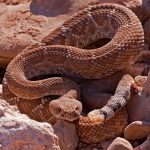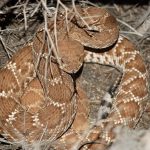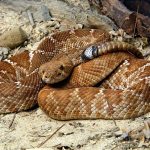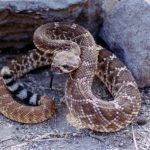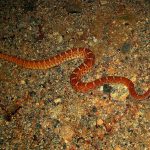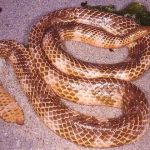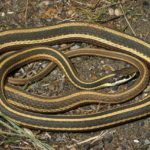Red Diamond Rattlesnake
Red diamond rattlesnake is a moderately large, poisonous, pit viper species occurring in the United States and Mexico. The species is mainly nocturnal and crepuscular during excessive hot weather, but also active during daytime when the temperature is moderate. Currently, there are three recognized subspecies of this species.
| Kingdom | Animalia |
| Phylum | Chordata |
| Subphylum | Vertebrata |
| Class | Reptilia |
| Order | Squamata |
| Suborder | Serpentes |
| Family | Viperidae |
| Subfamily | Crotalinae |
| Genus | Crotalus |
| Scientific Name | Crotalus ruber |
| Other Names | Red Rattlesnake, Red Diamond-backed Rattlesnake, Red Diamond Snake, Red Rattler |
| Length | 100 – 150 cm; largest recorded specimen measures 162 cm |
| Color | Reddish-tan, reddish-brown or brick red ground color with diamond-shaped patches on the back; dull yellow underside with black and white rings surrounding the tail |
| Distribution | Southwestern California (United States) and Baja California (Mexico) |
| Habitat | Arid scrub, coastal chaparral, woodlands, rocky grassland, cultivated areas, desert slopes of the mountains, rocky desert flats |
| Diet | Rabbits, ground squirrels, lizards, birds, other snakes |
| Hibernation Fact | Hibernate during winter |
| Venom Fact | Venomous |
| Breeding Season | February – April |
| Mode of Reproduction | Ovoviviparous (producing young by means of eggs hatched inside the body of the parent) |
| Litter Size | 3 to 20 young |
| Gestation Period | 5 to 6 months |
| Reproductive Age | Around 3 years of age in case of females |
| Average Lifespan | In wild: 15 to 16 years In captivity: Around 19 years |
| IUCN Conservation Status | Least Concern |
Red Diamond Rattlesnake Pictures Gallery
- Crotalus Ruber
- Red Diamond Rattlesnake Images
- Red Diamond Rattlesnake Photos
- Red Diamond Rattlesnake Pictures
- Red Diamond Rattlesnake
- Red Diamond Snake
- Red Rattlesnake
- Baby Red Diamond Rattlesnake
- Red Diamond Rattlesnake Habitat
- Red Diamond Rattlesnake Range


